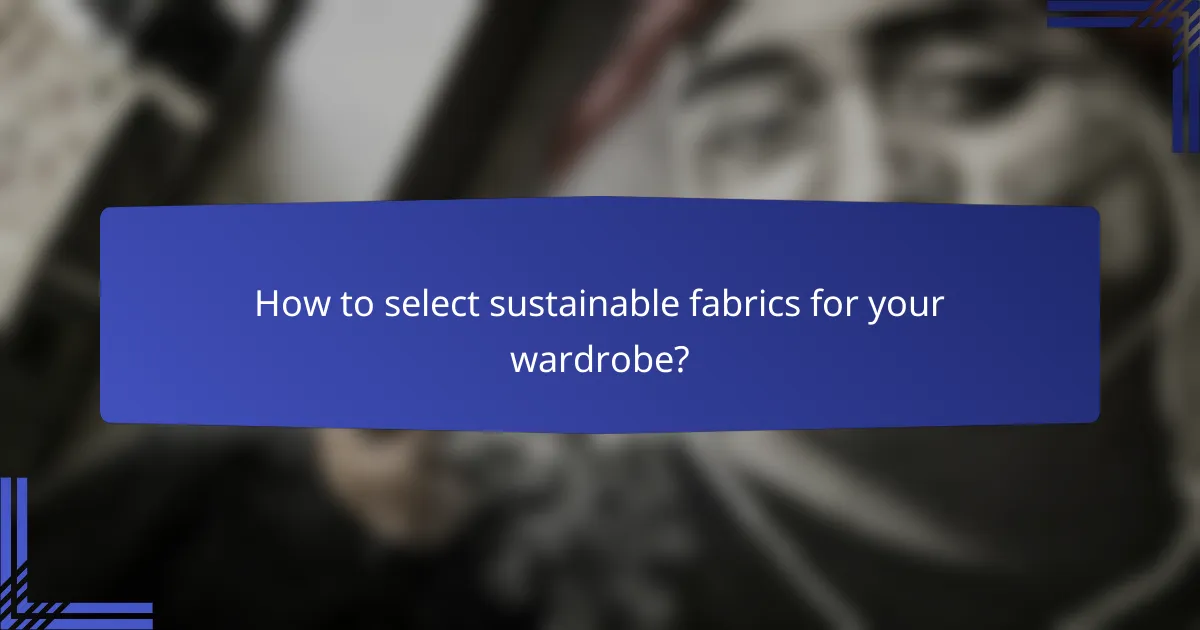Sustainable clothing is increasingly gaining attention as consumers seek to reduce waste and promote eco-friendly fashion choices. By integrating vintage pieces into your wardrobe, you can create a unique style while supporting sustainable practices. Additionally, choosing essential brands that prioritize ethical production and sustainable materials further enhances your commitment to a more responsible fashion industry.

How to integrate vintage clothing into a sustainable wardrobe?
Integrating vintage clothing into a sustainable wardrobe involves selecting unique pieces that reduce waste and promote eco-friendly fashion. By combining vintage items with modern styles, you can create a personalized look while supporting sustainable practices.
Mixing vintage with modern styles
Mixing vintage clothing with modern styles allows for creative expression and a unique wardrobe. Pair a vintage dress with contemporary accessories, or layer a vintage jacket over a modern outfit to create contrast. This approach not only enhances your style but also encourages the use of older garments in everyday fashion.
Consider balancing bold vintage pieces with minimalist modern items to avoid overwhelming your look. For example, a vibrant 70s blouse can be toned down with sleek, modern jeans, creating a harmonious blend of old and new.
Choosing timeless pieces
Selecting timeless vintage pieces is crucial for a sustainable wardrobe. Look for classic styles that transcend trends, such as a well-tailored blazer or a little black dress. These items can be worn across seasons and occasions, ensuring longevity in your collection.
Focus on quality materials and craftsmanship when choosing vintage items. Natural fabrics like wool, cotton, and silk often age better and can be more sustainable than synthetic alternatives. Aim for pieces that show minimal wear and can withstand regular use.
Upcycling vintage garments
Upcycling vintage garments involves creatively altering or repurposing them to extend their life and enhance their appeal. Simple modifications like shortening a dress or adding embellishments can transform outdated pieces into trendy items. This not only reduces waste but also personalizes your wardrobe.
Consider DIY projects such as turning a vintage shirt into a tote bag or patching up worn areas with fabric scraps. These projects can be enjoyable and rewarding, allowing you to express your creativity while practicing sustainability.
Supporting local vintage shops
Supporting local vintage shops is an effective way to integrate vintage clothing into your sustainable wardrobe. These shops often curate unique selections and promote sustainable practices by giving new life to pre-loved items. Shopping locally reduces the carbon footprint associated with shipping and supports small businesses.
Explore community events or markets that feature local vintage vendors. This not only helps you find one-of-a-kind pieces but also fosters a sense of community and encourages sustainable shopping habits. Look for shops that prioritize ethical sourcing and environmentally friendly practices to align with your sustainable goals.

What are the essential sustainable clothing brands?
Essential sustainable clothing brands focus on eco-friendly practices, transparency, and ethical production. Notable examples include Patagonia, Everlane, and Reformation, each offering unique approaches to sustainability in fashion.
Patagonia’s eco-friendly practices
Patagonia is renowned for its commitment to environmental responsibility. The brand uses organic cotton, recycled materials, and innovative processes to minimize waste and reduce carbon footprints.
Additionally, Patagonia encourages customers to repair and recycle their clothing through initiatives like the Worn Wear program, promoting a circular economy in fashion. This approach not only extends the life of garments but also fosters a culture of sustainability among consumers.
Everlane’s transparency model
Everlane stands out for its radical transparency, providing customers with detailed information about the costs of production and the factories where their clothes are made. This model allows consumers to understand the true price of clothing, including ethical labor practices.
The brand emphasizes quality over quantity, offering timeless wardrobe essentials that are designed to last. By focusing on fewer, high-quality pieces, Everlane helps reduce overconsumption and waste in the fashion industry.
Reformation’s sustainable collections
Reformation is known for its stylish, sustainable collections that prioritize eco-friendly materials and ethical manufacturing. The brand uses sustainable fabrics like Tencel and recycled polyester, aiming to minimize environmental impact while delivering trendy designs.
Reformation also tracks its environmental footprint, providing customers with insights into the impact of their purchases. This transparency helps shoppers make informed choices and supports a shift towards more sustainable fashion consumption.

How to select sustainable fabrics for your wardrobe?
Selecting sustainable fabrics involves considering their environmental impact, production methods, and durability. Focus on materials that are organic, biodegradable, and produced with minimal chemicals to ensure a lower ecological footprint.
Organic cotton benefits
Organic cotton is grown without synthetic pesticides or fertilizers, making it a safer choice for the environment and farmers. This method not only conserves water but also promotes biodiversity in farming practices.
When choosing organic cotton clothing, look for certifications like GOTS (Global Organic Textile Standard) to ensure the fabric meets strict environmental and social criteria. This can help you make informed decisions while shopping.
Linen’s environmental impact
Linen, made from the flax plant, is one of the most sustainable fabrics available. Flax requires less water and pesticides than cotton, making it a more eco-friendly option for your wardrobe.
Additionally, linen is biodegradable and has a long lifespan, which reduces the need for frequent replacements. When purchasing linen, seek out brands that prioritize sustainable practices in their production processes.
Tencel’s sustainability features
Tencel, derived from sustainably sourced wood pulp, is produced in a closed-loop process that recycles water and solvents, minimizing waste. This fabric is known for its softness and breathability, making it a comfortable choice for various clothing items.
When selecting Tencel garments, look for certifications like OEKO-TEX, which indicate that the fabric is free from harmful substances. This ensures that your clothing is not only sustainable but also safe for your skin.

What are the benefits of a sustainable wardrobe?
A sustainable wardrobe offers numerous advantages, including reduced environmental impact, support for ethical labor practices, and long-term financial savings. By choosing sustainable clothing options, individuals can contribute to a healthier planet and promote fair working conditions in the fashion industry.
Reduced environmental footprint
A sustainable wardrobe significantly lowers your environmental footprint by minimizing waste and resource consumption. Opting for vintage or second-hand clothing reduces the demand for new production, which often requires extensive water, energy, and raw materials.
Additionally, sustainable fabrics like organic cotton or recycled materials have a smaller ecological impact compared to conventional textiles. By making conscious choices, you can help decrease pollution and conserve natural resources.
Support for ethical labor practices
Building a sustainable wardrobe often involves supporting brands that prioritize ethical labor practices. Many sustainable clothing companies ensure fair wages and safe working conditions for their employees, which contrasts sharply with fast fashion’s exploitative practices.
When you choose to buy from these brands or opt for vintage clothing, you contribute to a more equitable fashion industry. Look for certifications like Fair Trade or GOTS (Global Organic Textile Standard) to identify companies committed to ethical labor.
Long-term cost savings
Investing in a sustainable wardrobe can lead to long-term cost savings. While sustainable clothing may have a higher upfront cost, these items are often made to last longer than fast fashion alternatives, reducing the need for frequent replacements.
Moreover, by focusing on quality over quantity, you can build a versatile wardrobe with timeless pieces that can be mixed and matched. This approach not only saves money but also encourages mindful consumption and reduces clutter.

How to care for vintage clothing sustainably?
Caring for vintage clothing sustainably involves using methods that minimize environmental impact while preserving the integrity of the fabric. This includes choosing gentle cleaning techniques, avoiding harsh chemicals, and ensuring proper storage to extend the life of these unique garments.
Eco-friendly washing techniques
When washing vintage clothing, opt for cold water and a gentle cycle to reduce energy consumption and prevent damage. Using a biodegradable detergent can further minimize environmental harm while effectively cleaning your garments.
Hand washing is another excellent eco-friendly technique, especially for delicate fabrics. Simply fill a basin with cool water, add a small amount of gentle detergent, and gently agitate the water before submerging the clothing. Rinse thoroughly to remove all soap residue.
Air drying is preferable to machine drying, as it saves energy and helps maintain the shape and quality of vintage items. Lay flat or hang garments in a shaded area to avoid sun damage, which can fade colors and weaken fibers.
